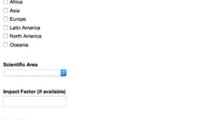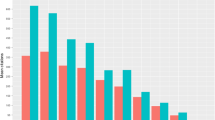Abstract
This paper reviews a range of studies conducted by the authors on indicators reflecting scholarly journal impact. A critical examination of the journal impact data in theJournal Citation Reports (JCR), published by the Institute for Scientific Information (ISI) has shown that the JCR impact factor is inaccurate and biased towards journals revealing a rapid maturing or decline in impact. In addition, it was found that the JCR cited half life is an inappropriate measure of decline of journal impact. More appropriate impact measures of scholarly journals are proposed. A new classification system is explored, describing both maturing and decline of journal impact as measured through citations. Suggestions for future research are made, analysing in more detail the distribution of citations among papers in a journal.
Similar content being viewed by others
References
Dubin, D.B., Arndt, K.A. (1995) The impact of dermatology journals.Archives of Dermatology, 131, 1059–1060.
Garfield, E. (1987)Current Contents, January 12.
Garfield, E. (1979)Citation Indexing. Its Theory and Applications in Science, Technology and Humanities, New York: Wiley.
Glänzel W., Schoepflin, U. (1994) A stochastic model for the ageing of scientific literature.Scientometrics, 30, 49–64.
Glänzel W., Schoepflin, U. (1995) A bibliometric study on ageing and reception processes of scientific Literature.Journal of Information Science, 21, 37–53.
Griffith, B.C., Servi, P.N., Anker, A.L., Drott, M.C. (1979) The aging of scientific literature: A citation analysis.Journal of Documentation, 35, 179–196.
Hansson, S. (1995) Impact Factor as a misleading tool in evaluation of medical journals.Lancet, 346, 906.
Line, M.B. (1970) The “Halflife” of periodical literature: Apparent and real obsolescence.Journal of Documentation, 26, 46–52.
Line, M.B., Sandison, A. (1974) “Obsolescence” and changes in the use of literature with time.Journal of Documentation, 30, 283–350.
Moed, H.F., Van Leeuwen, Th. N. (1995) Improving the accuracy of the Institute for Scientific Information's journal impact factor.Journal of the American Society for Information Science, 46, 461–467.
Moed, H.F., Van Leeuwen, Th. N. (1996) Impact Factors can mislead.Nature, 381, 186.
Moed, H.F., Van Leeuwen, Th. N., Reedijk, J. (1996) A Critical analysis of the Journals Impact Factors ofAngewandte Chemie and theJournal of the American Chemical Society: Inaccuracies in published Impact Factors based on overall citations only.Scientometrics, 37, 105–115.
Moed, H.F., Van Leeuwen, Th. N., Reedijk, J. (1998) A new classification system to describe the ageing of scientific journals and their impact factors.Journal of Documentation, 54, 387–419.
Seglen, P.O. (1997) Why the Impact Factor of journals should not be used for evaluating research?British Medical Journal 314, 498–502.
Seglen, P.O. (1997) Citations and Journal Impact Factors: Questionable indicators of research quality.Allergy, 52, 1050–1056.
Porta, M. (1996) The Bibliographic “Impact Factor” of the Institute for Scientific Information: How relevant is it really for public health journals?Journal of Epidemiology and Community Health, 50, 606–610.
Van Leeuwen, Th. N., Moed, H.F., Reedijk, J. (1997)JACS still toppingAngewandte Chemie: Beware of erroneous Impact Factors.Chemical Intelligencer, July, 32–36.
Author information
Authors and Affiliations
Rights and permissions
About this article
Cite this article
Moed, H.F., Van Leeuwen, T.N. & Reedijk, J. Towards appropriate indicators of journal impact. Scientometrics 46, 575–589 (1999). https://doi.org/10.1007/BF02459613
Received:
Issue Date:
DOI: https://doi.org/10.1007/BF02459613




